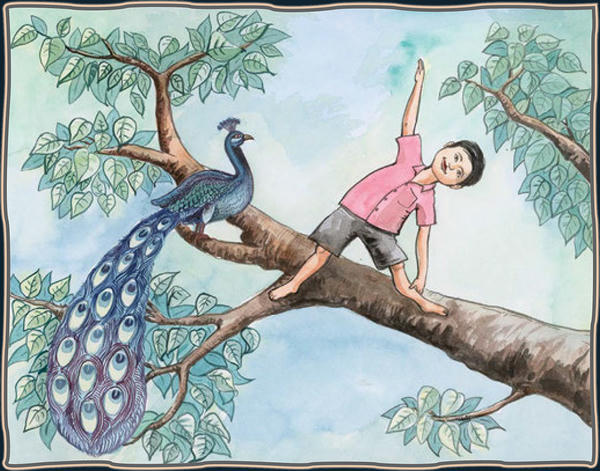
Younger brother has reached the third branch, where he deftly assumes a yoga posture designed to fine-tune his nervous system, balance his energies and prepare him for meditation. A peacock poses proudly nearby, demonstrating the poise and natural relaxation the boy yogi is striving for.§
Success in meditation requires the ability to sit in a comfortable posture, for long periods, without moving. Proper posture is necessary because the very simple act of equalizing the weight and having it held up by the spine causes you to lose body consciousness. Sit up nice and straight with the spine erect and the head balanced at the top of the spine.§
By sitting up straight, with the spine erect, the energies of the physical body are transmuted. Posture is important, especially as meditation deepens and lengthens. With the spine erect and the head balanced at the top of the spine, the life force is quickened and intensified as energies flood freely through the nerve system. In a position such as this, we cannot become worried, fretful, depressed or sleepy during our meditation. Learn to sit dynamically, relaxed and yet poised.§
Inwardly observe this posture and adjust the body to be poised and comfortable. Feel the muscles, bones and the nerve system. This posture is possible sitting in a chair, on a cushion, or on your knees. Ideally, a competent meditator will be able to cross the legs for meditation, either in full or half lotus. The hands are held in the lap, the right hand resting on the left, tips of the thumbs touching softly. In all cases, the posture should be natural and easy, and not cause discomfort, which is distracting during meditation. Look inwardly at the currents of the body. Observe their flow.§
If you just sit without moving, and breathe, the inner nerve system of the body of your psyche, your soul, begins to work on the subconscious, to mold it like clay. Awareness is loosened from limited concepts and made free to move vibrantly and buoyantly into the inner depths where peace and bliss remain undisturbed for centuries.§
The meditative poses are part of a larger system called hatha yoga, a system of bodily postures, or āsanas, created as a method for the yogi practicing yoga for long hours each day, performing japa and meditation, to exercise and keep the physical body healthy so that his meditations could continue uninhibited by disease or weakness. The purpose of haṭha yoga today again is the same—to keep the physical body, emotional body, astral body and mental body harmonious, healthy and happy so that awareness can soar within to the heights of divine realization. In our haṭha yoga we work with color, we work with sound and with the subtle emotions and feelings of the body when going from one āsana to another. Each āsana carefully executed, with regulated breathing, the visualization of color and the hearing of the inner sound, slowly unties the knotted vāsanās within the subconscious mind and releases awareness from there to mountaintop consciousness.§

